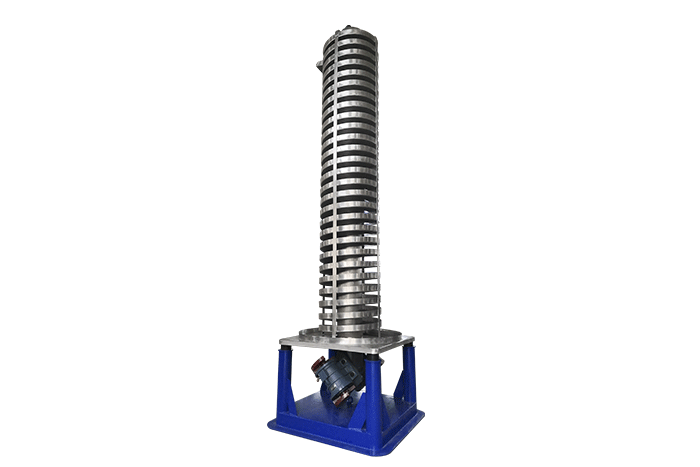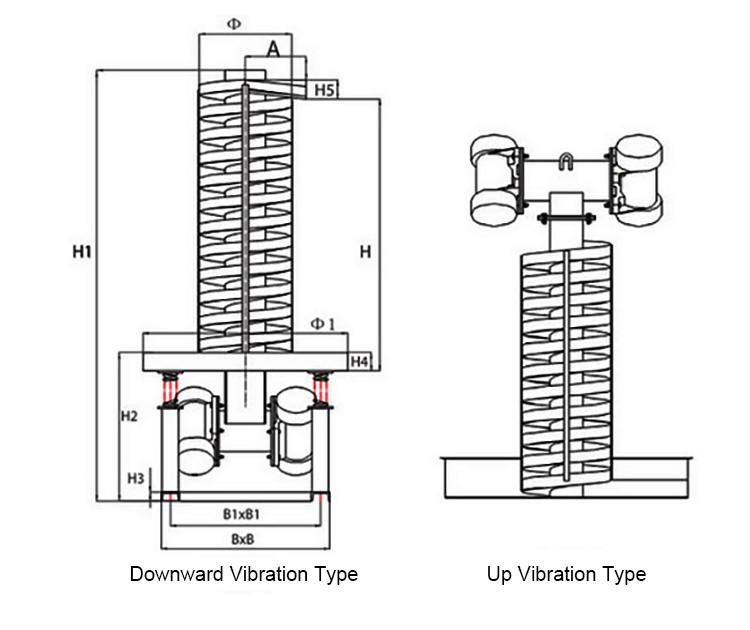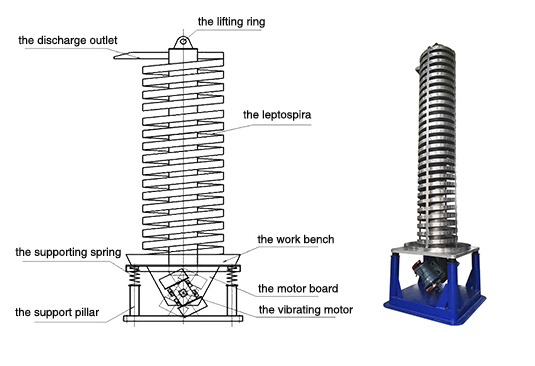
Vertical vibrating sprial elevator can convey granular, blocky, and powdery solid materials (with low viscosity). It is a new type of vertical vibration conveying equipment produced by our factory. It uses a vibration motor as a vibration source and uses the synthetic amplitude of two vibration motors to convey the material upward along the spiral conveyor trough.
Vertical vibrating sprial elevator has a simple structure, easy maintenance, quantitative material delivery, and continuously adjustable conveying volume. It can be used for vertical conveying of small particle materials in various industries. In addition to lifting materials from bottom to top, it can also complete the drying and cooling of materials. There are two structures: trough type and closed type. According to the requirements of different processes, screening elevators for material particle classification and elevators for flammable and explosive materials can be designed.
Small footprint: vertical layout, high space utilization, suitable for compact environment, reducing site costs.
Simplified and reasonable structure: simple and efficient design, reducing redundant components, enhancing stability and durability, and facilitating maintenance.
Low energy consumption operation: optimizing vibration and transmission systems to ensure efficient transportation while reducing energy consumption.
Low noise characteristics: using advanced shock absorption technology, quiet operation, hearing protection, and reducing environmental noise.
Modular and convenient maintenance: modular design facilitates quick disassembly and assembly of components, reduces maintenance costs, and shortens downtime.
Two-way conveying capacity: supports two-way conveying of materials up and down to meet diversified production needs.
Closed anti-pollution: fully enclosed design combined with efficient sealing effectively prevents dust and harmful gases from leaking, ensuring a clean and safe environment.
The structure of the Vertical vibrating sprial elevator is mainly composed of a lifting trough, a vibration motor, a vibration reduction system, and a base. The Vertical vibrating sprial elevator uses a vibration motor as the vibration source. The center lines of two vibration motors of the same model fixed on the lifting trough are installed at a certain angle and rotate in opposite directions. The eccentric block carried by the vibration motor generates a centrifugal force at each position during rotation, which reciprocates along the throwing direction, causing the entire body supported on the shock absorber to vibrate continuously, so that the material is thrown up in the lifting trough and moves upward at the same time. After the material falls into the feed trough, it begins to be thrown up. At this time, the material can come into contact with the air, and it can also play a role in heat dissipation and cooling. The elevator can vertically transport powdery, blocky and short-fiber solid materials (except sticky and easy to agglomerate), and can also complete the drying and cooling of the material. It is divided into two structures: open and closed.
1. Conveying trough and balanced chassis
The conveying trough (carrier, trough body) and balanced chassis (chassis) are the two main components of the vibrating conveyor system. The trough body conveys materials, and the chassis mainly balances the inertia force of the trough body and reduces the dynamic load transmitted to the foundation.
2. Exciter
The exciter is the power source of the vibrating conveyor and produces periodically changing exciting force, which makes the conveying trough and the balanced chassis produce continuous vibration. It can be divided into mechanical, electromagnetic, hydraulic and pneumatic types. The magnitude of its exciting force directly affects the amplitude of the conveying trough.
3. Main vibration spring and vibration isolation spring
The main vibration spring and vibration isolation spring are elastic elements in the vibrating conveyor system. The function of the main vibration spring: The main vibration spring supports the conveying trough and is usually installed at an angle with an inclined angle of ß (vibration angle). Its function is to make the vibrating conveyor have a suitable near-resonance working point, which is convenient for the system's kinetic energy and potential energy to be converted into each other and effectively utilize vibration energy. The function of the vibration isolation spring: support and reduce the dynamic load transmitted to the foundation or structural frame.
4. Guide rod
The function of the guide rod is to make the trough body and the base frame vibrate relative to each other along the vertical direction of the center line of the guide rod. It is connected to the trough body and the base frame through a rubber hinge.
5. Feeding device and unloading device
The feeding device and unloading device are used to control the material flow and are usually softly connected to the trough body.


| Model | Conveying capacity t/h | Material particle size mm | Conveying trough size width × height cm | Conveying distance m | Vibration times min | Motor power | Total amount kg |
| CZ250 | 1.0 | 50 | 25×25 | ~2.0 | 960 | 2×0.4 | 230 |
| CZ300 | 1.5 | 50 | 30×30 | ~3.0 | 960 | 2×0.4 | 305 |
| CZ400 | 2.0 | 50 | 40×30 | ~5.0 | 960 | 2×0.75 | 580 |
| CZ500 | 2.5 | 50 | 50×35 | ~6.0 | 960 | 2×1.5 | 880 |
| CZ600 | 3.0 | 50 | 60×40 | ~8.0 | 960 | 2×2.2 | 1280 |
| CZ700 | 3.5 | 50 | 70×40 | ~10 | 960 | 2×3.0 | 1850 |
Vertical vibration elevator can transport all granular, blocky and powdery solid materials. Therefore, it can be widely used in military, machinery, chemical, metallurgy, mining, rubber, plastic, light industry, pharmaceutical, food processing, grain, agriculture and animal husbandry and other industries as a lifting equipment for bulk powder and granular materials.
Vibration Vertical Elevator Selection Guide
You need to provide the following information, and we can provide you with free professional technical solutions:
1. Basic information: conveying volume, initial material temperature, temperature to which the material needs to drop, and lifting height.
2. Material properties: material name, material particle size and particle size composition, bulk density, temperature, humidity, viscosity, abrasiveness, corrosiveness, etc.
3. Working environment: heavy sky, indoor, dry, humid, ambient temperature, etc.
4. Unloading method and unloading device form.
5. Feeding method and feeding device form.
Thirty years of dedication have allowed us to accumulate extensive production and service experience, enabling us to solve various challenges in powder processing for our numerous clients.
Innovation is the lifeblood of our company's development. To date, we have obtained over 40 domestic and international patents, with many of our products holding multiple patents.
We specialize in undertaking the design and production of fine powder processing production lines, offering a one-stop service from crushing, screening, conveying, feeding, mixing to packaging.
Upon receipt of the products, detailed English user manuals are provided. For relatively complex installations or product usage, video installation guidance is available. For large-scale technical projects, we can dispatch professional technical personnel for on-site installation guidance.
 Please fill in the informationWe provide you with personalized solutions
Please fill in the informationWe provide you with personalized solutionsIf you do not know how to select, please call us or leave a message online. We will serve you wholeheartedly!